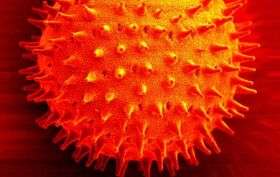Pollen Alert!

When you stroll through your front door in the morning, does the yellow haze coating the porch send you leaping back into the house? Can the mere word "pollen" make you start to sniffle, sneeze and reach for the tissue to blow your nose?
If you answered "yes" to these questions, you're probably one of millions of people in the United States suffering from hay fever. Pollen can do more, however, than just make you sneeze. If you have asthma, cardiovascular disease, chronic obstructive pulmonary disease or pneumonia, pollen can be downright dangerous. While most of the particles we inhale end up in shallow portions of our airways -- trouble enough! -- the tiniest shards can make their way dangerously deep into the lungs.
Some studies suggest that these little fragments of misery have extreme inflammatory potential and can impair human respiratory and cardiovascular-related health. For example, a study in the Netherlands uncovered a strong association between day-to-day variations in pollen concentrations and deaths from cardiovascular disease, chronic obstructive pulmonary disease, and pneumonia.
A NASA team, with help from academia, industry and health agencies, is exploring this tantalizing link between pollen, in this case juniper pollen, and some of these dangerous health conditions.
"Our research could really help people with pollen-related health issues," says team lead Jeff Luvall, Earth scientist at NASA's Marshall Space Flight Center in Huntsville, Ala.
The Center for Disease Control and Prevention is one of NASA's partners in the study. Len Flowers, from CDC's Environmental Public Health Tracking Program at the New Mexico Department of Health in Albuquerque, New Mexico, says, "We're exploring the relationship between two unprecedented recent juniper pollen peaks in northern New Mexico and the amount of sick leave taken by state employees at those times. We’re also looking at the asthma emergency department visits and hospitalizations in our communities, and at other respiratory and cardiovascular hospitalizations."
And what if they find the link they expect?
This is where NASA shines. Luvall's team has a solution ready -- and it comes from space. "Tiny pollen grains are transported in the wind, and we're using NASA satellite data to help predict pollen movement," says Luvall.
Accurate forecasts of pollen transport and dispersal could help reduce many of the maladies mentioned above by forewarning vulnerable people about pollen headed their way. In short, they'd know when to "take cover."
"The overarching goal is to use satellite images of greening plants to predict pollen bursts before they happen so that preventive measures can be taken," says Flowers.
How does it all work? We'll come to that in a moment. First, a pollen primer:
Basically, pollen is a container. It holds the male half of future offspring's genetic material. Its aim in life is to get to the female half by hook or by crook, by land or by sea, or, in this case, by wind or by bee. Wind-pollinated plants produce masses of pollen to ensure that at least some of it reaches its target. The real trouble begins when pollen is shattered into microscopic shards by changes in humidity while powerful thunderstorms suck up tremendous amounts of air and pollen from the surface of the Earth. Vigorous updrafts in thunderheads blast the pollen grains upward into the tops of clouds where the air is freezing, smashing the grains into fragments. Then the colder air sweeps back downward, swamping the draughts of air we breathe with shards of pollen.
Each research partner organization involved in this study wields a unique weapon to wage the pollen war. The first weapon is a forecaster's dream.
Slobodan Nickovic first conceived this DREAM, short for Dust Regional Atmospheric Model, to simulate how dust sweeps through the atmosphere across wide swaths of a continent. Now, with his assistance, the model has been modified at the University of Arizona to use pollen data instead of dust.
NASA has introduced MODIS, or the Moderate Resolution Imaging Spectroradiometer, into the pollen battle. MODIS is a sensor that resides on two NASA satellites -- Terra and Aqua. MODIS senses the growth stages of different plant species by looking at color changes that occur in the plant canopy. Certain color changes reveal when the plants are about to release their pollen hordes.
The New Mexico Department of Health's "weapon" takes the form of health record statistics that are crucial to the study.
In addition, the New Mexico Environmental Public Health Tracking Project and the ARES Corporation have alert systems that can be used to warn public health officials, doctors, hospitals, and schools, about incoming pollen. The health agency maintains a website that will alert the public to pollen events, and ARES Corporation's SYRIS, or Syndrome Reporting Information System, is a web-based system for alerting public health officials.
For this study, the researchers used data from MODIS to identify when and where juniper communities were pollinating. Alfredo Huete from the University of Arizona identified these time periods, via the MODIS data, for six different juniper communities throughout the U.S. southwest. These first DREAM pollen transport simulations modeled the pollen transport for 66 hours. The researchers propose next to establish a network of ground sampling stations to verify the model so it can be put to use in the future to help the pollen-endangered among us.
All of this is good news for the American public -- and for Luvall. "I do have a selfish reason for wanting this project to succeed," he confesses. "I'm allergic to tree pollen."
It's always good to be invested in your own work.
Source: Science@NASA, by Dauna Coulter




















